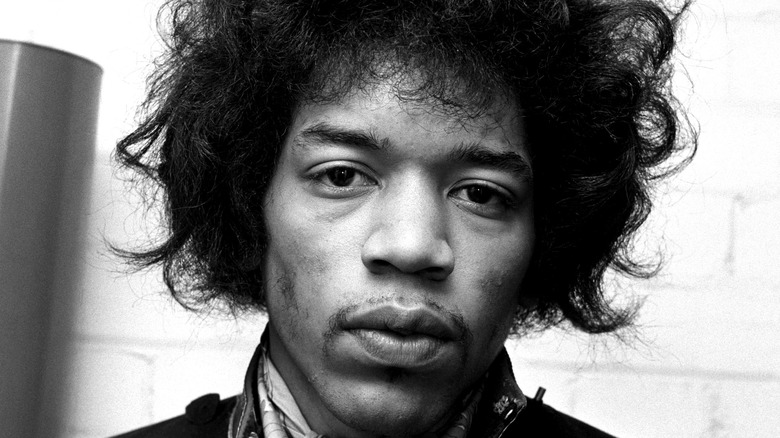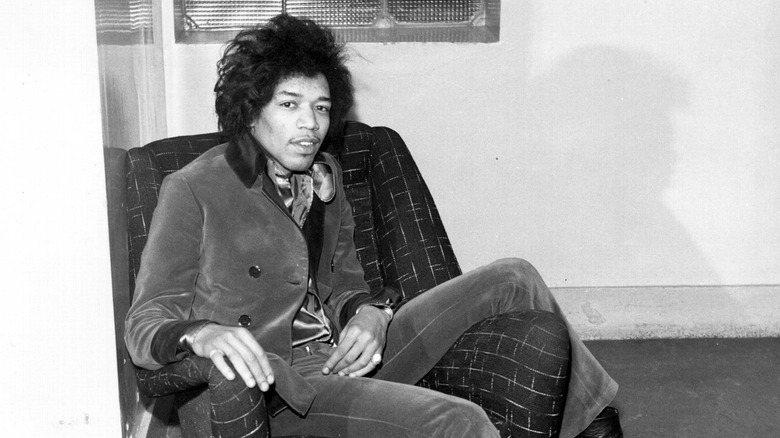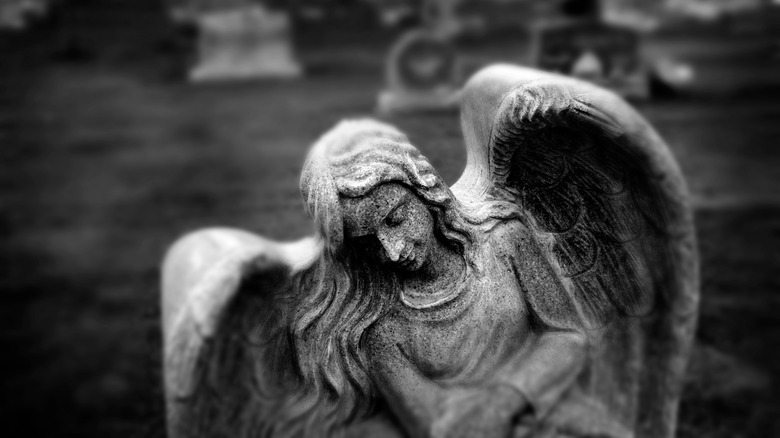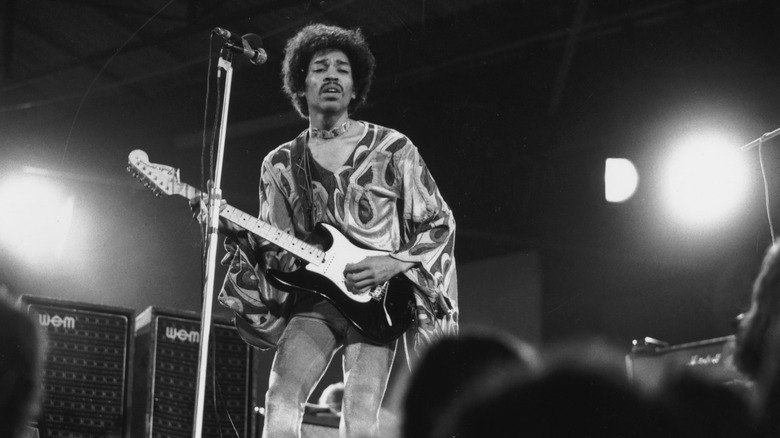The Death Of Jimi Hendrix's Mother Inspired One Of His Most Emotional Songs
We may receive a commission on purchases made from links.
Legendary guitarist Jimi Hendrix wrote most of the songs he released during his career, which was cut short in 1970 when he died of a drug overdose at 27 years old. Hendrix wrote hundreds of songs in his lifetime, and he revealed that a lot of them were written while he was in New York struggling to pay rent. Admittedly, the musician said that he can't write happy songs. In the book "Hendrix on Hendrix," he said, "I can write no happy songs. 'Foxey Lady' is about the only happy song I've written. Don't feel very happy when I start writing" (via American Songwriter).
Musicians who influenced Jimi's songwriting include Bob Dylan, Sam Cooke, Curtis Mayfield, and Muddy Waters, according to his step-sister, Janie Hendrix. He worked on songs whenever and wherever inspiration struck him, and he wrote his lyrics on anything available, including napkins and hotel notepads, as Janie told Music Radar. One piece of advice Jimi bestowed upon Janie was to keep paper and pen next to her while she slept, so that she could immediately write down her dreams upon waking. Jimi was also inspired by his dreams when he wrote songs, one of which was about his mother, Lucille.
Jimi Hendrix's family background
Johnny Allen Hendrix was born to 23-year-old Al Hendrix and 17-year-old Lucille Jeter in Seattle on November 27, 1942. The couple married in March of that year, and just three days after the wedding ceremony, Al — who was a private in the U.S. Army — was sent to duty in Alabama. Meanwhile, Lucille remained in Seattle and worked as a waitress and singer to earn money, as reported by the Seattle Times. Johnny Allen, who was given the name "Buster" or "Jimmy" was often left with her mother's friends when Lucille worked. After a couple of years, Al was contemplating divorcing his wife.
Al didn't push forward with the divorce, and the small family spent time together, but in the months and years following, the couple's relationship was troubled. They had financial issues, and it didn't help that both enjoyed drinking. They were stuck in a cycle of fighting, separating, and getting back together. The couple had four more children after Jimi. Leon, Joseph Allan or Joe, Kathy Ira, and Pamela. The two youngest were put in foster care, as they had health conditions and the couple couldn't afford to give them proper care. In 1951, the couple divorced and Al was given custody of the three boys. However, Joe, later on, became a ward of the state, as, like his sisters, he needed medical care that Al couldn't afford.
The death of Lucille Hendrix
After the divorce, Jimi Hendrix rarely spent time with his mother. Lucille eventually remarried a man who was significantly older than her. She continued to drink heavily, and by the late '50s, the effects of her drinking started to show. In 1957, Lucille was hospitalized twice for cirrhosis of the liver (per Cheat Sheet). Cirrhosis is the scarring of the liver due to disease or excessive alcohol intake, and the damage can't be reversed, as noted by Mayo Clinic.
In 1958, Lucille was brought to the hospital once again after she was discovered unconscious in an alley; she was diagnosed with hepatitis. On February 1, that year, Lucille died of a ruptured spleen at just 33 years old, according to the book "Becoming Jimi Hendrix." Jimi and his brother Leon hadn't seen their mother in months, but Leon recalled visiting her at the hospital. "They put her into a wheelchair, and she seemed to be all glowing white, like she was floating," he said. Jimi was devastated by his mother's death, and although he wasn't one to show his feelings, his aunt would hear him cry out on the porch after Lucille's death.
Jimi Hendrix's angel
Jimi Hendrix often turned to his dreams for inspiration when writing his songs. In an interview featured in the book "Starting at Zero: His Own Story," Hendrix explained that his song "Purple Haze" was inspired by a dream he had wherein he found himself stuck in a thick, purple fog while out in the ocean. Another song that was inspired by a dream is "Angel," which is part of the posthumous album "The Cry of Love," released in 1971.
As reported by Farout Magazine, Hendrix had a dream about his mother a couple of years before she died. In the dream, Lucille was on a camel with a big caravan bidding farewell to her son, saying, "I won't be seein' you too much anymore, you know. I'll see you." Her mother then disappeared underneath the shade of trees. Hendrix said that he never forgot that dream and two years later, her mother died. Hendrix started working on "Angel" in 1967, and he finished writing the lyrics a year later. In the opening lines, Hendrix sings about an angel coming down from heaven and staying just long enough for him to be rescued. And although the angel has gone back to heaven, the last line of the song refers to the angel always being by his side.



